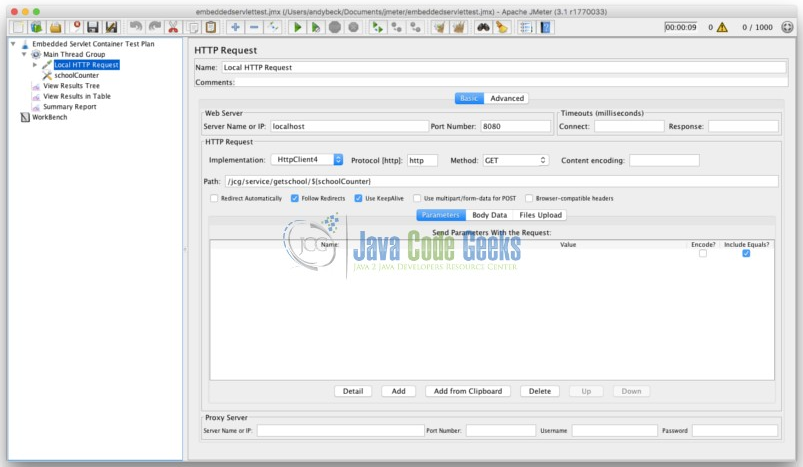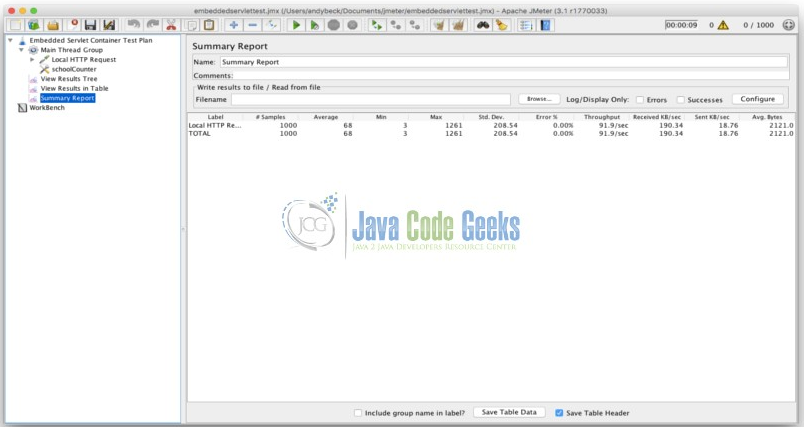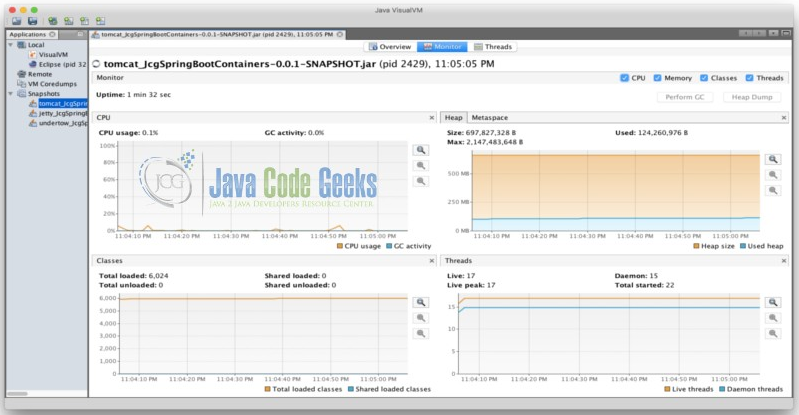Undertow
Spring Boot 内嵌容器Undertow参数设置
配置项:


# 设置IO线程数, 它主要执行非阻塞的任务,它们会负责多个连接, 默认设置每个CPU核心一个线程
# 不要设置过大,如果过大,启动项目会报错:打开文件数过多
server.undertow.io-threads=16 # 阻塞任务线程池, 当执行类似servlet请求阻塞IO操作, undertow会从这个线程池中取得线程
# 它的值设置取决于系统线程执行任务的阻塞系数,默认值是IO线程数*8
server.undertow.worker-threads=256 # 以下的配置会影响buffer,这些buffer会用于服务器连接的IO操作,有点类似netty的池化内存管理
# 每块buffer的空间大小,越小的空间被利用越充分,不要设置太大,以免影响其他应用,合适即可
server.undertow.buffer-size=1024 # 每个区分配的buffer数量 , 所以pool的大小是buffer-size * buffers-per-region
server.undertow.buffers-per-region=1024 # 是否分配的直接内存(NIO直接分配的堆外内存)
server.undertow.direct-buffers=true


来看看源代码:
https://github.com/undertow-io/undertow/blob/master/core/src/main/java/io/undertow/Undertow.java


ioThreads = Math.max(Runtime.getRuntime().availableProcessors(), 2); workerThreads = ioThreads * 8; //smaller than 64mb of ram we use 512b buffers
if (maxMemory < 64 * 1024 * 1024) {
//use 512b buffers
directBuffers = false;
bufferSize = 512;
} else if (maxMemory < 128 * 1024 * 1024) {
//use 1k buffers
directBuffers = true;
bufferSize = 1024;
} else {
//use 16k buffers for best performance
//as 16k is generally the max amount of data that can be sent in a single write() call
directBuffers = true;
bufferSize = 1024 * 16 - 20; //the 20 is to allow some space for protocol headers, see UNDERTOW-1209
}


很显然,Undertow认为它的运用场景是在IO密集型的系统应用中,并且认为多核机器是一个比较容易满足的点,Undertow初始化假想应用的阻塞系数在0.8~0.9之间,所以阻塞线程数直接乘了个8,当然,如果对应用较精确的估测阻塞系数,可以配置上去。
Spring Boot内嵌容器支持Tomcat、Jetty、Undertow。为什么选择Undertow?
这里有一篇文章,时间 2017年1月26日发布的:
Tomcat vs. Jetty vs. Undertow: Comparison of Spring Boot Embedded Servlet Containers
1. Setup Spring Boot Application
We will use Maven to setup a new project in Eclipse with the appropriate dependencies. We will use the starter parent for this example but the dependencies in a production application will likely be altered to streamline, optimize or customize.
1.1 Setup Spring Boot Dependencies
The default embedded servlet container is Tomcat. This version of Spring Web 1.4.3 brings in Tomcat version 8.5.6.
pom.xml


<parent>
<groupId>org.springframework.boot</groupId>
<artifactId>spring-boot-starter-parent</artifactId>
<version>1.4.3.RELEASE</version>
</parent> <dependencies>
<!-- TOMCAT -->
<dependency>
<groupId>org.springframework.boot</groupId>
<artifactId>spring-boot-starter-web</artifactId>
</dependency>
</dependencies>


1.2 Setup Spring Boot Main Application and Controllers
To setup the Spring Boot application you include the @SpringBootApplication annotation in your Main class. The @SpringBootApplication annotation brings in @SpringBootConfiguration, @EnableAutoConfiguration and @ComponentScanannotations.
Application.java
@SpringBootApplication
@ConfigurationProperties
public class Application {
public static void main(String[] args) {
SpringApplication.run(Application.class, args);
}
You may choose to eliminate this annotation and add the @SpringBootConfiguration alone or to another class that allows you to customize the configuration. The @ComponentScan will scan your application for items like the @Controller you will need to setup a RESTful service. The following controller will return a simple “Hello World” string from a HTTP GET request. We have also included in the bundled example another endpoint mapping that returns a complex object type.
SampleController.java


@Controller
public class SampleController { @Autowired
private ResourceLoader resourceLoader; @RequestMapping("/")
@ResponseBody
public String home() {
return "Hello World!";
}


1.3 Key Configuration Parameters
The default properties for all the embedded servlet containers are the same. Some of the most important properties to consider are the properties for configuring startup information like ports and application name, TSL, access logs, compression and many more.
For example, to configure SSL add the following to key value pairs to the application.properties.
application.properties
server.port=8443
server.ssl.key-store=classpath:keystore.jks
server.ssl.key-store-password=secret
server.ssl.key-password=another-secret
1.4 How to Find Additional Parameters
To explore the parameters for Spring boot applications you can add the Spring actuator dependency and the @ConfigurationProperties annotation to your Main class. You then visit the /configprops endpoint on your application to get a list of the available properties.
Application.java
@SpringBootApplication
@ConfigurationProperties
public class Application {
pom.xml
<dependency>
<groupId>org.springframework.boot</groupId>
<artifactId>spring-boot-starter-actuator</artifactId>
</dependency>
1.5 Change version of Embedded Servlet Containers
The embedded servlet container versions are defined in the following parent dependency from the pom. You can change the version of the embedded servlet container by explicitly including the dependency and identifying a new version in the pom. We will show you how in the examples below.
pom.xml
<dependency>
<groupId>org.springframework.boot</groupId>
<artifactId>spring-boot-dependencies</artifactId>
<version>1.3.7.RELEASE</version>
</dependency>
2. Tomcat
As Tomcat is the default embedded servlet container there is nothing you need to do to the default implementation to use Tomcat. You can change the version of Tomcat you are using or change properties in the pom.xml or application.properties files.
2.2 Change Version of Tomcat
pom.xml


<properties>
<tomcat.version>8.5.6</tomcat.version></properties>
<dependency>
<groupId>org.apache.tomcat.embed</groupId>
<artifactId>tomcat-embed-core</artifactId>
<version>${tomcat.version}</version>
</dependency>
<dependency>
<groupId>org.apache.tomcat.embed</groupId>
<artifactId>tomcat-embed-el</artifactId>
<version>${tomcat.version}</version>
</dependency>
<dependency>
<groupId>org.apache.tomcat.embed</groupId>
<artifactId>tomcat-embed-websocket</artifactId>
<version>${tomcat.version}</version>
</dependency>


3. Jetty
To change the embedded servlet container to Jetty you need to edit the pom file to remove the Tomcat dependency and add Jetty.
3.1 Change to Jetty (version 9.3.14)
pom.xml


<dependency>
<groupId>org.springframework.boot</groupId>
<artifactId>spring-boot-starter-web</artifactId>
<exclusions>
<exclusion>
<groupId>org.springframework.boot</groupId>
<artifactId>spring-boot-starter-tomcat</artifactId>
</exclusion>
</exclusions>
</dependency>
<dependency>
<groupId>org.springframework.boot</groupId>
<artifactId>spring-boot-starter-jetty</artifactId>
</dependency>


4. Undertow
To change the embedded servlet container to Undertow you need to edit the pom file to remove the Tomcat dependency and add Undertow.
4.1 Change to Undertow (version 1.3.24 final)
Notice the undertow version included in the spring boot starter is incorrect, referring to 1.3.25. You’ll need to change it to 1.3.24.Final for this to work at the time of this article.
pom.xml


<dependency>
<groupId>org.springframework.boot</groupId>
<artifactId>spring-boot-starter-web</artifactId>
<exclusions>
<exclusion>
<groupId>org.springframework.boot</groupId>
<artifactId>spring-boot-starter-tomcat</artifactId>
</exclusion>
</exclusions>
</dependency>
<dependency>
<groupId>org.springframework.boot</groupId>
<artifactId>spring-boot-starter-undertow</artifactId>
</dependency>
<dependency>
<groupId>io.undertow</groupId>
<artifactId>undertow-core</artifactId>
<version>1.3.24.Final</version>
</dependency>
<dependency>
<groupId>io.undertow</groupId>
<artifactId>undertow-servlet</artifactId>
<version>1.3.24.Final</version>
</dependency>


5. Performance and Load
In this example, we will analyze both the peformance of HTTP requests and the memory footprint at startup of all three embedded servlet containers. We used JMeter to measure performance by simulating load and JVisualVM to look at the memory footprint.
5.1 Measure Performance
In this example, we will analyze both the peformance of simple RESTFul GET requests that return a string and more complex GET requests that return complex JSON objects. JMeter is the tool used to measure the performance of the the three different types of containers. The key to setting up this test was establishing thread groups with the appropriate load, a counter to dynamically update the input to the API and report viewers to display or aggregate the results. For the simple string examples, we used a thread group with 1000 threads that would loop 3 times through the sequence. It also used a ramp up time of 10 seconds. For the complex object examples, we used the same parameters but did not loop.

JMeter Tomcat Thread Group

JMeter Tomcat Summary Report
5.1.1 Tomcat
5.1.1.1 Simple String
| Label | # Samples | Average | Min | Max | Std. Dev. | Error % | Throughput | Received KB/sec | Sent KB/sec | Avg. Bytes |
|---|---|---|---|---|---|---|---|---|---|---|
| Startup | 3000 | 7 | 1 | 549 | 35.78374361 | 0 | 293.8583603 | 55.95935572 | 55.67238466 | 195 |
| Others | 3000 | 1 | 0 | 45 | 1.359661682 | 0 | 287.8802418 | 54.82094449 | 54.53981144 | 195 |
| Others | 3000 | 1 | 0 | 24 | 1.155032275 | 0 | 292.1129503 | 55.62697785 | 55.3417113 | 195 |
5.1.1.2 Complex Object with Dynamic Data
| Label | # Samples | Average | Min | Max | Std. Dev. | Error % | Throughput | Received KB/sec | Sent KB/sec | Avg. Bytes |
|---|---|---|---|---|---|---|---|---|---|---|
| Startup | 1000 | 114 | 3 | 1601 | 322.8671905 | 0 | 97.68486861 | 202.3335999 | 19.93763432 | 2121 |
| Others | 1000 | 3 | 2 | 17 | 1.328216473 | 0 | 97.88566954 | 202.7495167 | 19.9786181 | 2121 |
| Others | 1000 | 2 | 1 | 16 | 1.110529603 | 0 | 98.52216749 | 204.0678879 | 20.10852833 | 2121 |
| Others | 1000 | 2 | 1 | 21 | 1.344498419 | 0 | 98.53187506 | 204.0879951 | 20.11050966 | 2121 |
5.1.2 Jetty
5.1.2.1 Simple Object
| Label | # Samples | Average | Min | Max | Std. Dev. | Error % | Throughput | Received KB/sec | Sent KB/sec | Avg. Bytes |
|---|---|---|---|---|---|---|---|---|---|---|
| Startup | 3000 | 7 | 0 | 561 | 40.13705065 | 0 | 291.5168594 | 56.0828333 | 55.22878 | 197 |
| Others | 3000 | 1 | 0 | 21 | 1.058925031 | 0 | 293.5995302 | 56.48350338 | 55.6233485 | 197 |
| Others | 3000 | 1 | 0 | 21 | 0.926034317 | 0 | 294.3485086 | 56.62759395 | 55.7652448 | 197 |
5.1.2.2 Complex Object with Dynamic Data
| Label | # Samples | Average | Min | Max | Std. Dev. | Error % | Throughput | Received KB/sec | Sent KB/sec | Avg. Bytes |
|---|---|---|---|---|---|---|---|---|---|---|
| Startup | 1000 | 110 | 3 | 1397 | 278.7961107 | 0 | 98.13542689 | 203.3626717 | 19.93375859 | 2122 |
| Others | 1000 | 3 | 2 | 20 | 1.500210319 | 0 | 98.48335631 | 204.0836739 | 20.00443175 | 2122 |
| Others | 1000 | 3 | 2 | 45 | 2.729377218 | 0 | 98.29942003 | 203.7025091 | 19.96706969 | 2122 |
5.1.3 Undertow
5.1.3.1 Simple Object
| Label | # Samples | Average | Min | Max | Std. Dev. | Error % | Throughput | Received KB/sec | Sent KB/sec | Avg. Bytes |
|---|---|---|---|---|---|---|---|---|---|---|
| Startup | 3000 | 6 | 0 | 451 | 31.6188702 | 0 | 295.6830278 | 63.81440346 | 56.01807363 | 221 |
| Others | 3000 | 1 | 0 | 22 | 1.255447862 | 0 | 292.7400468 | 63.17924839 | 55.46051669 | 221 |
| Others | 3000 | 1 | 0 | 18 | 1.559477975 | 0 | 294.3773918 | 63.53262069 | 55.77071681 | 221 |
5.1.3.2 Complex Object with Dynamic Data
| Label | # Samples | Average | Min | Max | Std. Dev. | Error % | Throughput | Received KB/sec | Sent KB/sec | Avg. Bytes |
|---|---|---|---|---|---|---|---|---|---|---|
| Startup | 1000 | 70 | 3 | 1114 | 197.1333241 | 0 | 97.059109 | 203.3969361 | 19.62044201 | 2145.893 |
| Startup | 1000 | 42 | 3 | 852 | 132.6443576 | 0 | 98.02960494 | 205.6324135 | 20.00799554 | 2148 |
| Others | 1000 | 3 | 2 | 19 | 1.293570253 | 0 | 98.55129595 | 206.6305004 | 20.01823199 | 2147 |
| Others | 1000 | 2 | 2 | 27 | 1.659250132 | 0 | 98.74592673 | 207.0385788 | 20.05776637 | 2147 |
| Others | 1000 | 2 | 1 | 17 | 1.260904041 | 0 | 98.28975821 | 206.0821395 | 19.96510714 | 2147 |
5.2 Measure Memory
To measure the memory of each embedded servlet container we looked at the memory usage on startup. JVisualVM is a tool provided with the Java Development Kit for visualizing the memory and footprint of java applications. We used this tool to show the initial startup impact of each of the three embedded servlet containers. The heap size and thread counts are key in analyzing this initial footprint. The ten threads that are common to all three containers include: JMX server connection timeout, RMI Scheduler, RMI TCP Connection (2), RMI TCP Accept, Attach Listener, DestroyJavaVM, Signal Dispatcher, Finalizer and Reference Handler.

JVisualVM Report
5.2.2 Tomcat
Heap Size: 697,827,328 B
Used: 124,260,976 B
Max: 2,147,483,648 B
Threads: 17 Live, 22 Started
5.2.3 Jetty
Heap Size: 628,621,312 B
Used: 311,476,776 B
Max: 2,147,483,648 B
Threads: 19 Live, 22 Started
5.2.4 Undertow
Heap Size: 630,718,464 B
Used: 114,599,536 B
Max: 2,147,483,648 B
Threads: 17 Live, 20 Started
6. 对比
6.1 性能
压测结果:从上面的6张压力测试报告中,可以看到3个容器在相同的用例及并发请求下,Undertow稍微比Tomcat和Jetty好一点。
资源消耗:JETY启动时内存占用最大,使用311 MB。Tomcat和Undertow的初始脚印相似,在120 MB左右,Undertow出现在114 MB的最低水平。响应头中的关键差异在于默认情况下默认情况下包括HTTP持久连接。该头将在支持持久连接的客户端中使用,以通过重用连接细节来优化性能。
6.1.1 Tomcat Response Headers
Content-Type →application/json;charset=UTF-8
Date →Mon, 09 Jan 2017 02:23:26 GMT
Transfer-Encoding →chunked
X-Application-Context →JcgSpringBootContainers:# Application index.
6.1.2 Jetty Response Headers
Content-Type →application/json;charset=UTF-8
Date →Mon, 09 Jan 2017 02:29:21 GMT
Transfer-Encoding →chunked
X-Application-Context →JcgSpringBootContainers:# Application index.
6.1.3 Undertow Response Headers
Connection →keep-alive
Content-Type →application/json;charset=UTF-8
Date →Mon, 09 Jan 2017 02:20:25 GMT
Transfer-Encoding →chunked
X-Application-Context →JcgSpringBootContainers:# Application index.
7. 结论
这些数字表明Undertow在性能和内存使用方面是最好的。令人鼓舞的是,Undertow 正在接受最新的能力,并默认为持久的连接。这些数字并不表示在这个例子中使用的负载有显著的性能差异,但我想它们会缩放,如果性能是最重要的因素,则Undertow 是应用程序的正确匹配。认为一个组织可能因为熟悉它的能力而喜欢嵌入的servlet容器也是合理的。很多时候默认设置将不得不改变,因为应用程序要求包括性能、内存使用和功能。
=========================分割线=================================================================================
在Spring Boot中使用 Undertow 而不是 Tomcat
1、Maven示例:


<dependency>
<groupId>org.springframework.boot</groupId>
<artifactId>spring-boot-starter-web</artifactId>
<exclusions>
<exclusion>
<groupId>org.springframework.boot</groupId>
<artifactId>spring-boot-starter-tomcat</artifactId>
</exclusion>
</exclusions>
</dependency>
<dependency>
<groupId>org.springframework.boot</groupId>
<artifactId>spring-boot-starter-undertow</artifactId>
</dependency>


2、配置Undertow,application.yml示例:


server.undertow.accesslog.dir= # Undertow access log directory.
server.undertow.accesslog.enabled=false # Enable access log.
server.undertow.accesslog.pattern=common # Format pattern for access logs.
server.undertow.accesslog.prefix=access_log. # Log file name prefix.
server.undertow.accesslog.rotate=true # Enable access log rotation.
server.undertow.accesslog.suffix=log # Log file name suffix.
server.undertow.buffer-size= # Size of each buffer in bytes.
server.undertow.buffers-per-region= # Number of buffer per region.
server.undertow.direct-buffers= # Allocate buffers outside the Java heap.
server.undertow.io-threads= # Number of I/O threads to create for the worker.
server.undertow.max-http-post-size=0 # Maximum size in bytes of the HTTP post content.
server.undertow.worker-threads= # Number of worker threads.


3、使用 Undertow 监听多个端口示例:


@Bean
public UndertowEmbeddedServletContainerFactory embeddedServletContainerFactory() {
UndertowEmbeddedServletContainerFactory factory = new UndertowEmbeddedServletContainerFactory();
factory.addBuilderCustomizers(new UndertowBuilderCustomizer() { @Override
public void customize(Builder builder) {
builder.addHttpListener(8080, "0.0.0.0");
} });
return factory;
}

Undertow的更多相关文章
- spring servlet 扩展undertow
官方地址:http://undertow.io/documentation/servlet/servlet-extensions.html 留待学习中,mark一下 源码地址:https://git ...
- Spring Boot 2.0 教程 | 配置 Undertow 容器
欢迎关注个人微信公众号: 小哈学Java, 文末分享阿里 P8 资深架构师吐血总结的 <Java 核心知识整理&面试.pdf>资源链接!! 文章首发于个人网站 https://ww ...
- jfinal undertow web.xml
由于 undertow 是为嵌入式 server 而生,所以 jfinal undertow 项目是不需要 web.xml 这个文件的 线上这版 Filter.Servelt.Listener.Web ...
- io.undertow.websockets.jsr.ServerWebSocketContainer cannot be cast to org.apache.tomcat.websocket.server.WsServerContainer
Caused by: java.lang.ClassCastException: io.undertow.websockets.jsr.ServerWebSocketContainer cannot ...
- SpringBoot-将servlet容器变成undertow测试tomcat吞吐量
将Servlet容器变成Undertow 默认情况下,Spring Boot 使用 Tomcat 来作为内嵌的 Servlet 容器 可以将 Web 服务器切换到 Undertow 来提高应用性能.U ...
- springboot undertow替换tomcat方式
版权声明: https://blog.csdn.net/weixin_38187317/article/details/81532560说明 undertow,jetty和tomcat可 ...
- Undertow的InMemorySessionManager
https://github.com/undertow-io/undertow/blob/master/core/src/main/java/io/undertow/server/session/In ...
- Spring Boot 容器选择 Undertow 而不是 Tomcat
Spring Boot 内嵌容器Undertow参数设置 配置项: # 设置IO线程数, 它主要执行非阻塞的任务,它们会负责多个连接, 默认设置每个CPU核心一个线程 # 不要设置过大,如果过大,启动 ...
- springboot不使用内置tomcat启动,用jetty或undertow
Spring Boot启动程序通常使用Tomcat作为默认的嵌入式服务器.如果需要更改 - 您可以排除Tomcat依赖项并改为包含Jetty或Undertow: jetty配置: <depend ...
- Undertow,Tomcat和Jetty服务器配置详解与性能测试
undertow,jetty和tomcat可以说是javaweb项目当下最火的三款服务器,tomcat是apache下的一款重量级的服务器,不用多说历史悠久,经得起实践的考验.然而:当下微服务兴起,s ...
随机推荐
- Django 之一些request封装的常用功能
一些常用的request对象属性 介绍 HTTP 应用的信息是通过 请求报文 和 响应报文 传递的,关于更多的相关知识,可以阅读<HTTP权威指南>获得. 其中 请求报文 由客户端发送,其 ...
- http协议与soap协议之间的区别
http是标准超文本传输协议.使用对参数进行编码并将参数作为键值对传递,还使用关联的请求语义.每个协议都包含一系列HTTP请求标头及其他一些信息,定义客户端向服务器请求哪些内容,服务器用一系列HTTP ...
- 提高前端开发效率的N种方法
一.使用固定的html模板和css公共样式 事先把模板建好,每次需要用的时候直接拿来就行,不再需要为浏览器兼容问题考虑太多时间 这里我整理了一套,希望对大家有帮助:http://www.cnblogs ...
- vue学习(4)-组件的创建,父子组件传值,$refs
模块化:代码逻辑 组件化:UI 组件的创建:1.
- 工作流引擎Activiti
背景: 在计算机尚未普及时,许多工作流程采用手工传递纸张表单的方式,一级一级审批签字, 工作效率非常低下,对于数据统计以及生成报表的功能,需要经过大量的手工操作才能实现. 随着电脑的普及,这些工作的参 ...
- laravel 框架 数据库迁徙时SQLSTATE[420000]错误
问题: SQLSTATE[42000]: Syntax error or access violation: 1071 Specified key wa s too long; max key le ...
- swoole| swoole 协程初体验 转
swoole| swoole 协程初体验 date: 2018-5-30 14:31:38title: swoole| swoole 协程初体验description: 通过协程的执行初窥 swo ...
- 【Hibernate】一级缓存
一.概述 二.证明Hibernate的一级缓存的存在 三.一级缓存中快照区 四.管理一级缓存 五.Hibernate一级缓存的刷出时机 六.操作持久化对象的方法 一.概述 什么是缓存: 缓存将数据库/ ...
- 《数据结构与算法之美》 <07>队列:队列在线程池等有限资源池中的应用?
我们知道,CPU 资源是有限的,任务的处理速度与线程个数并不是线性正相关.相反,过多的线程反而会导致 CPU 频繁切换,处理性能下降.所以,线程池的大小一般都是综合考虑要处理任务的特点和硬件环境,来事 ...
- Python内存数据序列化到硬盘上哪家强
1. 闲扯一下:文件 磁盘上的数据,我们一般称为 “文件” ,一般不同的文件都有各自的后缀名,比如 .txt .docx .xlsx .jpg .mp3 .avi .这些不同类型的文件一般分为两大类: ...
